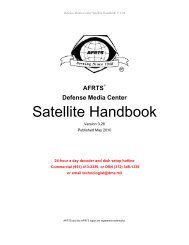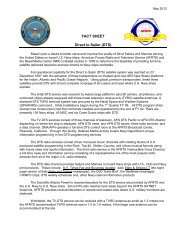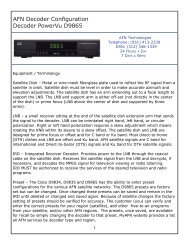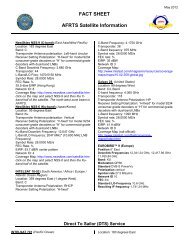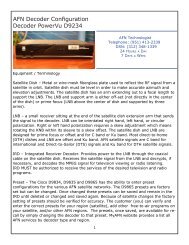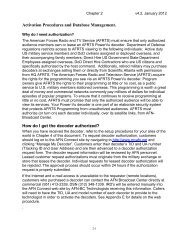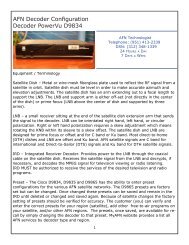American Forces Information Service February 1998 - afrts
American Forces Information Service February 1998 - afrts
American Forces Information Service February 1998 - afrts
Create successful ePaper yourself
Turn your PDF publications into a flip-book with our unique Google optimized e-Paper software.
FACT SHEET<br />
AFRTS Satellite Network (SATNET)<br />
S e r v i n g Since 1942<br />
May 2009<br />
In 1969, the <strong>American</strong> <strong>Forces</strong> Radio and Television <strong>Service</strong> (AFRTS) was among the first<br />
organizations to use satellites as a means of transmitting television programming. Today, AFRTS provides<br />
radio and television programming by satellite 24 hours-a-day, to 177 countries and U.S. territories.<br />
Using an Intelsat Galaxy satellite, AFRTS provides satellite service to the U.S. base in Honduras and<br />
the Naval Base at Guantanamo Bay, Cuba. Additionally, this satellite provides connectivity for the network’s<br />
Atlantic and Pacific satellites.<br />
Using an Intelsat satellite over the Atlantic Ocean, AFRTS serves DoD personnel in Africa, the Middle<br />
East, and on the islands of Diego Garcia, Iceland and the Azores (Portugal).<br />
Korea.<br />
In the Pacific, two SES New Skies satellites carry the AFRTS signal to DoD personnel in Japan and<br />
A satellite superstation concept is used in the European Hemisphere to deliver regional radio and<br />
television services. In Germany and Italy, the <strong>American</strong> <strong>Forces</strong> Network-Europe (AFN-E) uplinks to two<br />
Eutelsat HotBird satellites which are received at sites throughout Europe, North Africa, the Middle East, and<br />
many parts of Southwest Asia.<br />
All AFRTS satellite transmissions use the Scientific-Atlanta PowerVu ® digital compression system to<br />
allow the transmission of multiple channels of television and radio services over a single satellite transponder.<br />
This system employs digital conditional access encryption to protect the programming from being received by<br />
unauthorized audiences. SATNET provides full-time, live, radio and television services from the United<br />
States to service members, DoD civilians, and their families serving overseas.<br />
-0-



